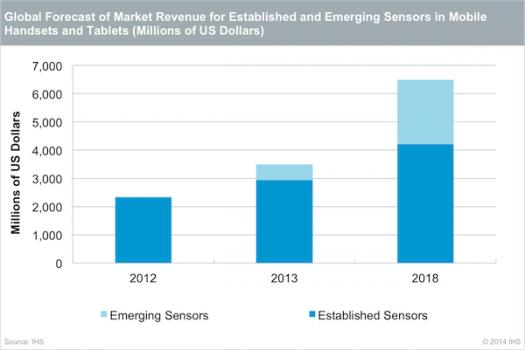Apple and Samsung Drive Adoption of Next-Generation Sensors

Propelled by the race between Apple and Samsung to enhance their mobile products with cutting-edge sensor technology, the market for sensors in cellphones and tablets is set to nearly triple from 2012 through 2018, according to IHS Technology.
Worldwide market revenue for sensors used in mobile handsets and media tablets will rise to $6.5 billion in 2018, up from $2.3 billion in 2012, as presented in the attached figure. The fastest-expanding portion of the mobile sensor segment will be emerging devices, whose revenue will surge to $2.3 billion in 2018, up from just $24 million in 2012. In 2013, this segment posted dramatic growth, with revenue rising to more than $500 million.
"The next wave of sensor technology in smartphones and tablets has arrived," said Marwan Boustany, IHS senior analyst for microelectromechanical systems (MEMS) and sensors. "Led by Apple and Samsung, the mobile market is moving beyond simply integrating established devices like motion sensors and now is including next-generation features like fingerprint and environment/health sensors. Adoption of these newer devices will drive the expansion of the mobile sensor device market in the coming years."
Established sensors in mobile devices include motion sensors, light sensors and MEMS microphones. Emerging sensors consist of new devices including fingerprint, optical pulse, humidity, gas, ultraviolet (UV) and thermal imaging.
Heightened sensors
Apple initiated the market for fingerprint sensors in mobile devices with the release of the iPhone 5s in 2013.
"Fingerprint sensors have arrived in force. IHS forecasts that shipments of fingerprint-enabled devices will reach 1.4 billion units in 2020," Boustany said. "This is more than four times the 317 million units expected to be shipped by the end of 2014."
The fingerprint sensor market is beginning to gain traction at other companies outside of Apple. New devices with fingerprint sensors include Samsung's flagship model"”the Galaxy S5"”and Huawei's top-of-the-line smartphone, the Ascend Mate 7, both of which began shipping in 2014.
For its part, Samsung has pioneered the deployment of other devices, including environmental and health sensors in the flagship models introduced by the company during the last 18 months. Samsung rolled out a humidity sensor in the Galaxy S4, a pulse sensor in the Galaxy S5 and a UV sensor in the Note 4.
Asian sensation
Fingerprint sensors play a key role in mobile payment services, providing authentication for systems like Apple Pay. Other banks and financial institutions, including Visa, MasterCard and PayPal are also working to support mobile payments and biometric authentication.
"This fingerprint market has all its requirements for success converging at the right time," Boustany said.
Mobile payment services are expected to gain popularity not just in Europe and North America, but also in Asia.
With the increasing demand for sensor technology in Asia, IHS expects Chinese smartphone original equipment manufacturers (OEM) to be the next driver for a new generation of sensors.
Humidity sensors have been used in Chinese handsets since 2011. In the future, air-quality sensors will experience growing usage in China.
The first gas sensors have just been designed in by Chinese smartphone OEMs. IHS expects these phones will enter the market during the first half of 2015. There is also a specific demand for sensors that can detect particle pollution in large Chinese cities such as Beijing or Shanghai.
Extrasensory perception
In terms of revenue, fingerprint sensors now dominate the mobile market, followed by optical pulse sensors, humidity and UV sensors. IHS anticipates gas sensors will join the fray in 2015 and thermal imagers will arrive during the 2018 time period.
Thermal imagers using microbolometer sensors emerged from the technology of forward-looking infrared (FLIR) systems in 2014 as accessories for the iPhone 5s. However, it will take a few more years before these sensors decline enough in pricing to be embedded in smartphones.
IHS predicts that Samsung will adopt gas/chemical sensors in the Note 6 that will be introduced in 2016. This is because gas/chemical sensor technology will have matured and use cases will be more clearly defined by then.
Some sensors that have appeared in smartphones are likely to migrate to wearables, which in some cases are better platforms for health or environmental sensors.
New IHS Technology report entitled Emerging Sensors in Handsets & Tablets Report "“ 2014 from the Semiconductors & Components service.

































